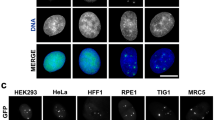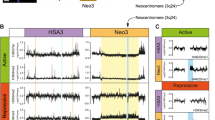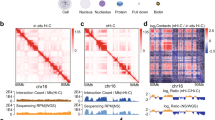Abstract
We report the results of the genome-wide alignment of inter- and intra-chromosomal chromatin interactions within the context of interphase chromatin binding to nuclear lamina and nucleolus. For all human chromosomes, a significant correlation exists between binding of chromosomal loci to nuclear lamina and segregation into spatially-defined distinct compartments of genome-wide chromatin interactions identified by Hi-C method. We report identification of near-centromeric intergenic regions on human chromosomes (chr2; chr10; chr17; chr1), which are highly enriched for interphase chromatin homing sites and function as attractors of long-range physical interactions (Centromeric Regions of Interphase Chromatin Homing, CENTRICH). CENTRICH are engaged in 397-1526 pair-wise interactions per 1 Kb distance, which represents 199 - 716-fold enrichment of interphase chromatin homing sites compared to genome-wide average (2-tail Fisher's exact test p values range 2.10E-101 - 1.08E-292). CENTRICH represent unique for human highly homologous DNA sequences of 3.9 - 22.4 Kb in size which are: 1) associated with nucleolus; 2) exhibit remarkably diverse regulatory protein contexts of chromatin state maps; 3) bind multiple intergenic disease-associated genomic loci (IDAGL) with documented long-range enhancer activities and established links to increased risk of developing epithelial malignancies and other common human disorders. For cancer, coronary artery disease, and type 2 diabetes, there is a statistically significant inverse correlation between the genome-wide association studies (GWAS)-defined odds ratios of increased risk of a disease and distances of SNP loci homing sites to the middle-point genomic coordinates of CENTRICH. We conclude that interactions with nucleolus and nuclear lamina may have a physiologically and pathologically significant global impact on 3D genome architecture by governing a dynamic transition of large segments of interphase human chromosomes from the open loop to folded fractal globule conformations. We propose that emergence of CENTRICH in genome's architecture during the evolution contributes to distinct phenotypic features of H.sapiens.
Similar content being viewed by others

Article PDF
Author information
Authors and Affiliations
Corresponding author
Rights and permissions
About this article
Cite this article
Glinsky, G. Unique for human centromeric regions of interphase chromatin homing (CENTRICH) govern dynamic features of chromatin fractal globules. Nat Prec (2012). https://doi.org/10.1038/npre.2012.6756.1
Received:
Accepted:
Published:
DOI: https://doi.org/10.1038/npre.2012.6756.1


